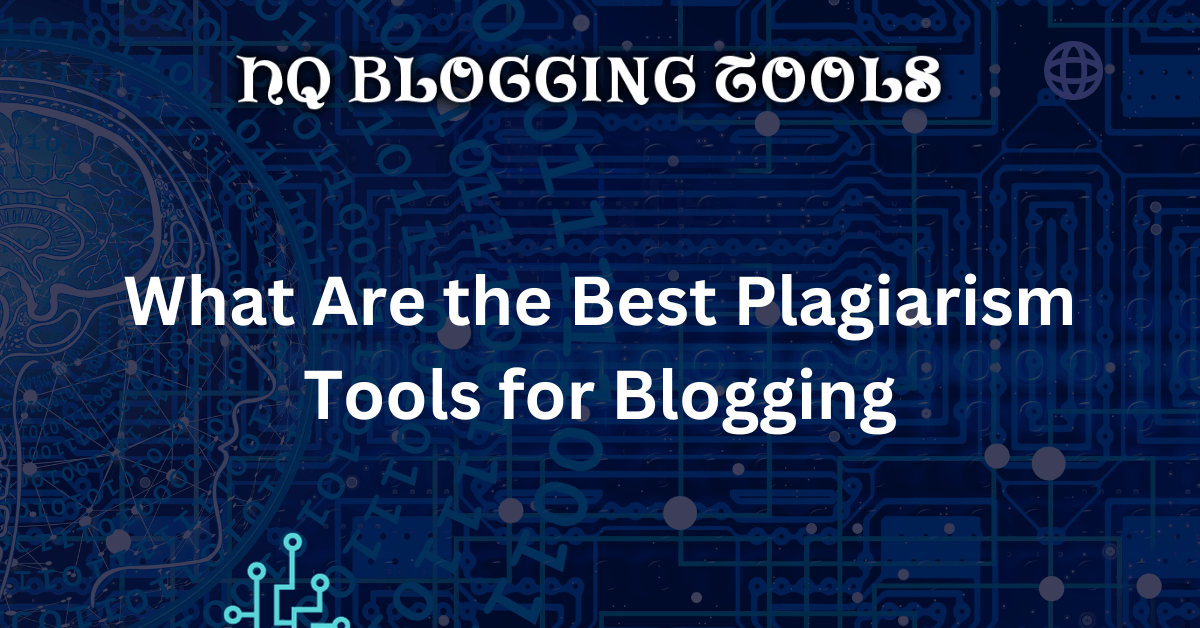Imagine you’re writing a report for school. You want to make sure your information is accurate, so you read a lot of books and articles. But sometimes, it’s hard to remember everything you’ve read. And if you accidentally copy someone else’s words without giving them credit, that’s plagiarism!
Bloggers have the same problem. They write a lot of articles, and they want to make sure their information is original. That’s why they use special tools called plagiarism checkers. These best plagiarism tools scan the blogger’s writing against a huge database of other articles to see if there are any matches. If the tool finds a match, the blogger knows they need to check their work and make sure they’re giving proper credit to the original source.
Table Of Contents
Top Plagiarism Detection Tools for Bloggers
To help you combat plagiarism, we have compiled a list of the top plagiarism detection tools for bloggers:
- Grammarly: Renowned for its grammar and spell-checking capabilities, Grammarly also offers a robust plagiarism detection feature. It scans your content against billions of web pages, identifying any potential instances of plagiarism and providing detailed citations.
- Copyscape: A pioneer in the plagiarism detection industry, Copyscape is known for its accuracy and comprehensiveness. It not only detects plagiarism but also provides detailed reports, including links to the original sources.
- Quetext: Utilizing advanced algorithms, Quetext goes beyond mere plagiarism detection and analyzes the structure and similarity of sentences. It also provides suggestions for paraphrasing to enhance originality.
- Plagiarisma: Simple yet effective, Plagiarisma offers a user-friendly interface and supports multiple languages. It scans your content against a vast database of web pages, identifying potential plagiarism and providing detailed reports.
- Plagium: Boasting a unique approach, Plagium utilizes semantic analysis to compare the meaning of your content with existing sources. This approach ensures that even paraphrased plagiarism is detected.
Key Features and Benefits of the Best Plagiarism Tools for Blogging
When choosing a plagiarism detection tool for your blogging needs, consider the following key features and benefits:
- Accuracy: The ability to accurately detect plagiarism across various sources is crucial for bloggers. Reliable plagiarism tools can help identify even subtle instances of plagiarism, ensuring the originality of your content.
- Comprehensiveness: Effective plagiarism tools scan your content against a vast database of web pages, including academic journals, news articles, and personal blogs. This comprehensive scanning ensures that no potential source is overlooked.
- Detailed Reporting: Plagiarism detection tools should provide detailed reports, including links to the original sources and suggestions for paraphrasing. These reports help bloggers understand the extent of plagiarism and make necessary corrections.
- User-Friendliness: Ease of use is essential for bloggers who may not have extensive technical expertise. Simple interfaces, intuitive navigation, and clear instructions make plagiarism tools accessible to all.
- Multilingual Support: For bloggers who cater to a global audience, multilingual support is crucial. Plagiarism tools that support multiple languages can effectively detect plagiarism across various languages.
Choosing the Right Plagiarism Tool: Factors to Consider for Bloggers
To select the right plagiarism tool for your blogging needs, consider the following factors:
- Needs and Budget: Consider your specific needs and budget when choosing a plagiarism tool. Free tools may offer basic functionality, while paid tools may provide more advanced features and support.
- Accuracy and Comprehensiveness: Prioritize tools that offer high accuracy and comprehensiveness, ensuring that your content is thoroughly scanned for potential plagiarism.
- Reporting and Paraphrasing Suggestions: Choose tools that provide detailed reports and suggestions for paraphrasing, making it easier to rectify any plagiarism issues.
- User-Friendliness: Opt for tools with a user-friendly interface and easy-to-understand instructions, especially if you are not tech-savvy.
- Multilingual Support: If your blog targets a global audience, select a tool that supports multiple languages to effectively detect plagiarism across different languages.
Additional Tips for Avoiding Plagiarism
In addition to using plagiarism detection tools, you can also take steps to avoid plagiarism by:
- Paraphrasing and summarizing information: Instead of directly copying text from sources, paraphrase or summarize the information in your own words.
- Properly citing sources: Always cite your sources using a consistent style guide, such as APA or MLA.
- Creating original content: Strive to create original content that reflects your Own ideas and insights.
Conclusion
Plagiarism detection tools are indispensable for bloggers, ensuring the originality and integrity of their content. By utilizing these tools effectively, bloggers can maintain their credibility, avoid reputational damage, and protect their intellectual property. Carefully consider the key features, benefits, and factors when selecting the right plagiarism tool for your blogging needs.
